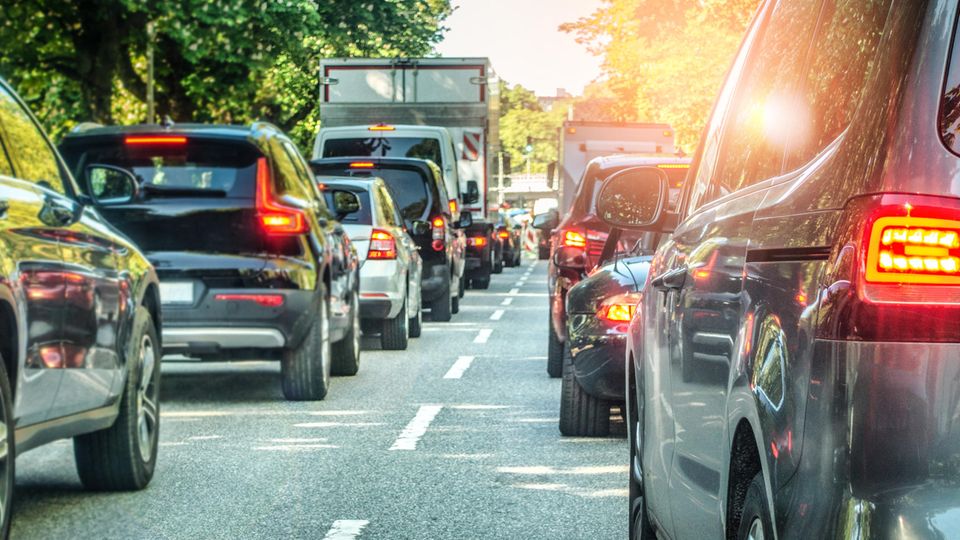Greener living
Car-free neighborhoods: How traffic projects affect residential areas
Cars are no longer welcome in the Graefekiez in Berlin Kreuzberg – parking lots will soon become green and loading areas.
© Britta Pedersen / DPA
In large cities, cars are increasingly having to give way to green spaces and cycle paths. That could encourage gentrification — and keep rents rising.
Scientifically supported traffic projects like these, in which cars have to give way at least temporarily so that cyclists, children playing and pedestrians have more space and safety, also exist in other large cities. In Munich’s Untergiesing district, traffic-calming measures on Kolumbusstrasse recently made the headlines. A few days ago, the administrative court in Cologne overturned a corresponding traffic attempt on Deutzer Freiheit. Projects of this kind are considered important for the near future, in which significantly less car traffic will be needed in the fight against climate change and a reallocation of road space. Nevertheless, they are increasingly discussed ideologically.
Does Banning Cars Promote Gentrification?
In the heated debate, however, there are counter-arguments that make traffic researchers sit up and take notice. One of these is: where parking spaces and cars have to give way, neighborhoods and quarters would become more expensive. The measures promoted displacement and gentrification. If that were the case, the neighborhoods without cars would be more livable – but only for those who can afford the area. Is that so?
“The connection is basically conceivable,” says Matthias Wanner, traffic researcher at the Wuppertal Institute, a non-profit research institution. So far, however, there have been hardly any scientific studies on this. “You have to differentiate what is happening at this point: Is parking space becoming scarcer or more expensive? Is through traffic made more difficult? Different measures have different effects.”
There are some facts that contradict the notion that fewer cars drive higher rents and displacement. One of them: the less money people have, the fewer cars they have.
In 2018, more than half of people with very low economic status did not have a car at all, according to data from the Federal Environment Agency. In contrast, only eight percent of people with very high incomes were traveling without a car at all. “So you could also argue that I make a neighborhood unattractive, especially for high-income groups, if I restrict its car usability from the outset,” says Wanner.
Car-free zones fuel fears of further increases in rents
But it’s not that easy. Surveys before the pilot project in the Graefekiez had shown that approval of the restrictions on cars increased with increasing levels of education and income, says traffic researcher Andreas Knie from the Berlin Social Science Center. “The lower the income and the level of education, the more critical the project was viewed, and that doesn’t correlate with car ownership,” he emphasizes. “You can only assume that the fear behind it is that even more people with more money will come to this district.”
Knie therefore sees a connection between gentrification and traffic-calming measures – but exactly the opposite: “Where areas were gentrified beforehand, where the higher educated classes are now located, traffic calming is also taking place.”
On this point, too, the research situation is thin. The non-profit Verkehrsclub Deutschland refers to a study by the University of Westminster, among others, in the “Journal of Transport Geography” from 2021. In it, the authors examined the distribution of traffic-calmed areas in the London city area. They conclude that, at least at the London borough level, traffic calming measures are distributed relatively evenly among fewer and more disadvantaged areas. But such analyzes allow little conclusions about other cities or countries.
Traffic-calmed areas could lead to social mixing
However, Anne Klein-Hitpass and Ricarda Pätzold, traffic and social researchers at the German Institute for Urban Studies in Berlin, do not rule out a connection between traffic-calming measures and the social mix in neighborhoods. “The assumption is plausible that this is exactly what happens,” says Pätzold.
Nevertheless, they do not want to accept this fact as an argument against traffic measures. “The argument always comes up when an excuse is sought when something is not wanted,” emphasizes Klein-Hitpass. But that doesn’t mean that areas should be made more attractive and livable for people.
From the point of view of science, there is no clear answer to the question. Rather, from the point of view of the experts, possible effects of transport policy measures on the composition of the districts remain something that local politics must keep in mind in order to take social countermeasures if necessary. Because a functioning turnaround in traffic needs the acceptance of local residents.



